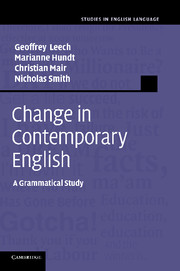Book contents
- Frontmatter
- Contents
- List of figures
- List of tables
- Preface
- Abbreviations and symbolic conventions
- 1 Introduction: ‘grammar blindness’ in the recent history of English?
- 2 Comparative corpus linguistics: the methodological basis of this book
- 3 The subjunctive mood
- 4 The modal auxiliaries
- 5 The so-called semi-modals
- 6 The progressive
- 7 The passive voice
- 8 Take or have a look at a corpus? Expanded predicates in British and American English
- 9 Non-finite clauses
- 10 The noun phrase
- 11 Linguistic and other determinants of change
- Appendix I The composition of the Brown Corpus
- Appendix II The C8 tagset used for part-of-speech tagging of the four corpora
- Appendix III Additional statistical tables and charts
- References
- Index
11 - Linguistic and other determinants of change
Published online by Cambridge University Press: 18 January 2010
- Frontmatter
- Contents
- List of figures
- List of tables
- Preface
- Abbreviations and symbolic conventions
- 1 Introduction: ‘grammar blindness’ in the recent history of English?
- 2 Comparative corpus linguistics: the methodological basis of this book
- 3 The subjunctive mood
- 4 The modal auxiliaries
- 5 The so-called semi-modals
- 6 The progressive
- 7 The passive voice
- 8 Take or have a look at a corpus? Expanded predicates in British and American English
- 9 Non-finite clauses
- 10 The noun phrase
- 11 Linguistic and other determinants of change
- Appendix I The composition of the Brown Corpus
- Appendix II The C8 tagset used for part-of-speech tagging of the four corpora
- Appendix III Additional statistical tables and charts
- References
- Index
Summary
This final chapter will reverse the procedure we have normally followed so far: the ‘bottom up’ methodology outlined in Chapter 2 (section 2.3). According to that methodology, the natural way for corpus linguistics to operate is to work from the identification and quantification of formal phenomena in texts towards the functional interpretation of the resulting findings. Our method in this chapter, however, is to begin with types of functional explanation, and to consider them in relation to the various formal phenomena they might explain. This will include gathering together the functional explanations we have (tentatively) offered here and there in various chapters, to see how far they lend support to one another. But focusing on function rather than form will also give us the opportunity to go beyond the limited set of grammatical topics covered up to now – verb categories and their constructions, plus one chapter on the noun phrase – and to touch on extra topics, such as negation, and extra levels of language, such as morphology and punctuation. Ultimately, of course, wherever possible, we would like to identify common motivations – rooted in discourse conventions, the sociolinguistic dynamic or even the general socio-cultural context of the late twentieth century – which may reveal unexpected relations between changes which we have so far discussed largely in isolation.
- Type
- Chapter
- Information
- Change in Contemporary EnglishA Grammatical Study, pp. 236 - 272Publisher: Cambridge University PressPrint publication year: 2009

